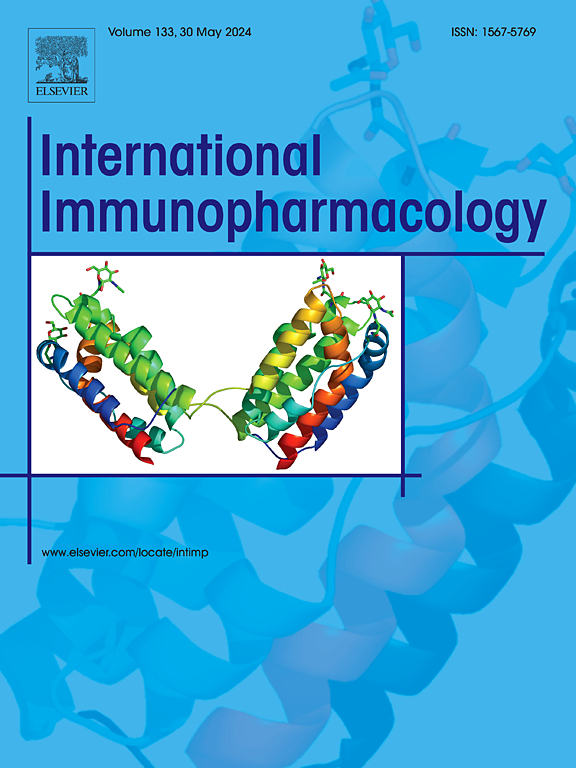泛素偶联酶E2S (UBE2S)作为骨肉瘤的预后生物标志物和肿瘤发生调节因子
IF 4.8
2区 医学
Q2 IMMUNOLOGY
引用次数: 0
摘要
泛素偶联酶E2S (UBE2S)是泛素偶联酶的一个成员,与骨肉瘤(OS)的关联尚不清楚。本研究旨在利用TCGA和GEO数据库的数据评估UBE2S在OS中的预测价值。采用Kaplan-Meier生存分析和ROC曲线进行预后评价,并采用nomogram进行预后预测。分析了潜在的生物学功能、途径及其与肿瘤免疫微环境、免疫治疗反应和药物敏感性的相关性。UBE2S过表达与预后不良相关,nomogram可有效预测OS生存结局。发现UBE2S影响OS的肿瘤发生途径、免疫景观和治疗敏感性。转录组测序、RT-qPCR、Western Blotting和免疫组织化学证实UBE2S在OS中异常过表达。此外,一系列体外实验表明,UBE2S敲除可减少OS细胞的增殖和迁移,同时促进细胞凋亡。体内实验也证实了UBE2S敲低可以抑制OS细胞的生长。总之,我们的研究表明,UBE2S是OS的可靠预后因素。它的异常过表达增强了OS的增殖和迁移,这表明它对未来OS的个性化治疗策略具有重要意义。本文章由计算机程序翻译,如有差异,请以英文原文为准。
Ubiquitin-conjugating enzyme E2S (UBE2S) as a prognostic biomarker and regulator of tumorigenesis in osteosarcoma
Ubiquitin-conjugating enzyme E2S (UBE2S) is a member of ubiquitin conjugating enzymes with unclear association with osteosarcoma (OS). This study aimed to assess UBE2S's predictive value in OS using data from TCGA and GEO databases. Kaplan-Meier survival analysis and ROC curves were used for prognostic evaluation, and a nomogram was developed for prognostic prediction. Potential biological functions, pathways, and correlations with tumor immune microenvironment, immunotherapy response, and drug sensitivity were analyzed. UBE2S overexpression was linked to poor prognosis, and the nomogram effectively predicted OS survival outcomes. UBE2S was found to impact tumorigenesis pathways, immune landscape, and treatment sensitivity in OS. Transcriptome sequencing, RT-qPCR, Western Blotting, and immunohistochemistry confirmed that UBE2S is abnormally overexpressed in OS. Additionally, a series of in vitro experiments showed that UBE2S knockdown reduced OS cell proliferation and migration while promoting apoptosis. In vivo experiments also confirmed that UBE2S knockdown could inhibit OS cell growth. In summary, our research demonstrates that UBE2S is a reliable prognostic factor for OS. Its abnormal overexpression enhances OS proliferation and migration, indicating its significance for future personalized treatment strategies in OS.
求助全文
通过发布文献求助,成功后即可免费获取论文全文。
去求助
来源期刊
CiteScore
8.40
自引率
3.60%
发文量
935
审稿时长
53 days
期刊介绍:
International Immunopharmacology is the primary vehicle for the publication of original research papers pertinent to the overlapping areas of immunology, pharmacology, cytokine biology, immunotherapy, immunopathology and immunotoxicology. Review articles that encompass these subjects are also welcome.
The subject material appropriate for submission includes:
• Clinical studies employing immunotherapy of any type including the use of: bacterial and chemical agents; thymic hormones, interferon, lymphokines, etc., in transplantation and diseases such as cancer, immunodeficiency, chronic infection and allergic, inflammatory or autoimmune disorders.
• Studies on the mechanisms of action of these agents for specific parameters of immune competence as well as the overall clinical state.
• Pre-clinical animal studies and in vitro studies on mechanisms of action with immunopotentiators, immunomodulators, immunoadjuvants and other pharmacological agents active on cells participating in immune or allergic responses.
• Pharmacological compounds, microbial products and toxicological agents that affect the lymphoid system, and their mechanisms of action.
• Agents that activate genes or modify transcription and translation within the immune response.
• Substances activated, generated, or released through immunologic or related pathways that are pharmacologically active.
• Production, function and regulation of cytokines and their receptors.
• Classical pharmacological studies on the effects of chemokines and bioactive factors released during immunological reactions.

 求助内容:
求助内容: 应助结果提醒方式:
应助结果提醒方式:


